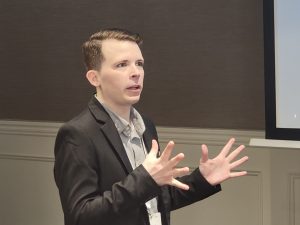Innovation is Perishable – Best Practices for Successful Idea Management
Editor’s Note: This is a guest post by Paul Pluschkell, CEO & Co-Founder of Spigit
![]() People often ask me what makes an innovation community a success; is it the caliber of the ideas? Who participates? How much money is invested in creating the community? And while all these questions are relevant I tend to take a step back and answer these questions by asking some myself, starting with what are you trying to accomplish, because innovation for innovation’s sake won’t work.
People often ask me what makes an innovation community a success; is it the caliber of the ideas? Who participates? How much money is invested in creating the community? And while all these questions are relevant I tend to take a step back and answer these questions by asking some myself, starting with what are you trying to accomplish, because innovation for innovation’s sake won’t work.
Launched in 2007, Spigit provides innovation management tools to companies that recognize that good ideas can emerge from the communities within, either internal (employees) or external (customer and partners). Since deploying our first community in July of 2007 we have gained tremendous insight into the key factors that help make innovation communities successful.
In this article I outline the key practices that will greatly increase the quality of the ideas, shape people’s attitude and make the best use of these sites. The key is to approach the project not just as opening up a website to your employees, customers and partners; but about building an innovation community that is collaborative and transparent. The way you shape and form the community will greatly influence the caliber of ideas that people submit and their willingness to contribute.
Relevant goals
The first is having a relevant business goal or problem that you are looking to solve. This seems like a no-brainer, but many companies come to us with a vague idea of what they want, or something too general. Simply asking for your employees’ ideas won’t deliver the most value. There are two parts to creating an effective community – first is understanding and sharing the business goals and having a sound vision for the community. Second, is presenting the business goals to the community users so that they can easily understand what they need to do to contribute relevant ideas.
As an example, a domestic airline’s goal was to create “the iPod of innovation for the airline industry.” Something so big and broad will garner ideas, but it’s really too large of a theme for most people to grasp. Such a broad goal can discourage users from participating as they may believe they do not have a game changing idea that matches that broad topic.
Also, a broad topic can result in a company missing out on an incremental idea that may not exactly match the topic, but may result in huge cost savings. We worked with our client to identify the real business goal, which was to grow revenue in various areas of the business. Focusing on that theme and creating categories that would help users post ideas about growing revenue made the site easy to understand for all participants. By framing the discussion around growing revenue, the client may very well find the “iPod of the airline industry,” but they won’t miss out on opportunities presented in incremental innovation.
Manage your community
![]() The second key principle is to have adequate community management. Don’t think of it as just a website, it’s a community, and the community needs a representative that understands how the ideas will feed into the pipeline and can communicate with the community on how to participate, what is happening to the ideas, etc. It’s important that users don’t feel like their ideas are going into a black hole and that they know who to ask when they have questions about the process or need help with a specific feature.
The second key principle is to have adequate community management. Don’t think of it as just a website, it’s a community, and the community needs a representative that understands how the ideas will feed into the pipeline and can communicate with the community on how to participate, what is happening to the ideas, etc. It’s important that users don’t feel like their ideas are going into a black hole and that they know who to ask when they have questions about the process or need help with a specific feature.
Having one or two people who are able to provide guidance and help users along the way establishes the essential transparency and trust that users need in order to contribute the best ideas. The CIO from our client, the City of Manor, TX has done an excellent job of this. He is not only extremely active in the community, but he is available to answer questions and help users along the way. Many community managers may choose to blog on the site, provide important announcements on the homepage and in general make their presence felt and be accessible.
The third key principle is having executive sponsorship. You are asking people to take time out of their busy day to do something that is likely not directly related to their job. Therefore, they need to see that this is important to the business and that it is really worth their while. One of the most effective ways of doing this is to have an executive sponsor “present” the site by sending out the invitation email, or posting a video of themselves talking about the importance of innovation for the organization or best, by participating in the process.
![]() A global telecommunications firm launched an incredibly successful community and I believe this was largely due to the fact that they have strong executive backing. Not only does the CTO sit on the board of advisors who evaluate the ideas, but he is active on the site, using available features such as the contest feature which demonstrates the importance of innovation and the commitment the company is making to ideas emerging from the ground up.
A global telecommunications firm launched an incredibly successful community and I believe this was largely due to the fact that they have strong executive backing. Not only does the CTO sit on the board of advisors who evaluate the ideas, but he is active on the site, using available features such as the contest feature which demonstrates the importance of innovation and the commitment the company is making to ideas emerging from the ground up.
Of course, there are many factors that can help make the community successful. The above will help in establishing the community, but it is equally important to have an implementation plan for the ideas that emerge as well as budget to fund the best ideas. It is equally important to follow up with the users who entered ideas and keeping the community abreast of what is happening with their ideas and those that are being implemented. Using communication channels and marketing the site will effectively lead to more users, thereby increasing the diversity of ideas that will in turn create a much richer and rewarding environment. Lastly, rewards and incentives continue to be an important aspect of employee engagement and keeping the site interesting, and it is sure to attract more people to your community.
The secret sauce
In summation, the secret sauce is to create an enterprise social networking site that people want to participate in and that fosters collaboration. Spigit accomplishes this with three fundamental principles; software algorithms to rate and rank people and ideas, game mechanics to foster a fun and fulfilling experience, and behavioral science methodology to draw participation. Innovation is perishable – make sure that yours is not!
About Spigit
Spigit has enjoyed great success in the first half of 2010 with record number of new customers, explosive revenue and employee growth. In three short years we have become the leader in idea management software based on new customer acquisitions and total revenue. Our customers include a who’s who of the best global brands including: Cisco, AAA, Pfizer, and Southwest Airlines. Our success is primarily based on the fact that we build purpose-built social networking tools for enterprises that allows them to take advantage of their scale through collaboration of all employees, customers and partners to increase the rate of innovation, drive revenue and cut costs.
In October of 2009 Warburg Pincus invested in Spigit. The funding was primarily used as expansion capital to grow our core business and build for scale. This past quarter Spigit achieved growth of 287 percent compared to the previous quarter and solid growth of 308 percent compared to the same quarter last year. We doubled our customer base and grew our employee base by 107% since January 1, 2010. Further, Spigit opened a professional services office in Boulder, CO, a sales office in the Washington, D.C. area and has expanded its office space in Pleasanton, CA.
About the Author
![]() Paul Pluschkell, CEO & Co-Founder, Spigit
Paul Pluschkell, CEO & Co-Founder, Spigit
For over 18 years, Paul has founded and led successful and profitable high-tech strategic organizations of both private and public companies. Currently Paul is CEO and Co-Founder of Spigit, an enterprise social software provider. Prior to founding Spigit, Paul was a Senior Executive at global media and telecommunication firms, and CEO of high tech financial markets. Paul’s first company MXNet successfully merged with another company and went public in 1999. Paul’s background with content, networks and algorithmic trading was the genesis of the creation of Spigit.
A message from John Furrier, co-founder of SiliconANGLE:
Your vote of support is important to us and it helps us keep the content FREE.
One click below supports our mission to provide free, deep, and relevant content.
Join our community on YouTube
Join the community that includes more than 15,000 #CubeAlumni experts, including Amazon.com CEO Andy Jassy, Dell Technologies founder and CEO Michael Dell, Intel CEO Pat Gelsinger, and many more luminaries and experts.
THANK YOU













